Effects of Non-Metallic Inclusions and Mean Stress on Axial and Torsion Very High Cycle Fatigue of SWOSC-V Spring Steel
Abstract
1. Introduction
2. Material and Method
2.1. Testing Material
2.2. S-N Tests under Axial and Torsion Loading
2.3. Fatigue Crack Growth Tests Using Specimens with Artificial Defects
3. Results
3.1. S-N Data
3.2. Crack Initiating Inclusions
3.3. Near Threshold Fatigue Crack Growth
4. Discussion
- Solid lines with a slope of −1/6 in Figure 7 predict the fatigue limit in the short crack regime using Equations (9) and (10).
- Solid lines with a slope of −1/2 in Figure 7 predict the fatigue limit in the long crack regime using the long crack threshold stress intensity factor amplitude, Ka,th,lc, according to Equation (11):
5. Conclusions
- 1.
- Inclusions can be considered as initial cracks. measured on the plane perpendicular to the maximum principal stress determines the deleterious influence of an inclusion. Therefore, aluminates are deleterious for axial and torsion loading, whereas elongated MnS inclusions aligned in a rolling direction solely initiate cracks under torsion loading.
- 2.
- Crack initiation and propagation at aluminates are in mode I under axial and torsion loading. Crack initiation at MnS inclusions under torsion loading is in mode II/III, followed by further crack growth in mode I. For both types of inclusions and both loading conditions, the threshold for mode I crack growth determines the fatigue limit.
- 3.
- The long crack threshold stress intensity amplitude in vacuum at R = −1 for limiting growth rates of 10−13 m/cycle is 3.7 MPa . of inclusions is in the short crack regime where the threshold stress intensity decreases with decreasing crack length and failures can occur at lower stress intensities.
- 4.
- Murakami and Endo’s parameter model predicts the axial loading fatigue limit at R = −1 within the reported prediction error of 10%. The influence of biaxiality on torsion loading of a material defect is considered with a factor of 0.86. The factor accounts for the mean stress sensitivity. With this, the following equation was successfully used to predict the fatigue limit for cyclic axial loading at different R-ratios:
- 5.
- Cyclic torsion properties in the presence of inclusions can hardly be deduced from cyclic axial properties: Shape and orientation of inclusions influence their harmfulness, size effects cause different distributions of inclusion sizes, and R-ratio sensitivity was found to be different for axial and torsion loading. Ultrasonic cyclic torsion tests with different mean loads are most appropriate for rapidly collecting torsion fatigue data of material.
Author Contributions
Funding
Institutional Review Board Statement
Informed Consent Statement
Data Availability Statement
Conflicts of Interest
Nomenclature
| square root of the projection area of a small, arbitrary-shaped defect perpendicular to the major principal stress direction | |
| HV | Vickers hardness |
| Ka | stress intensity factor amplitude |
| R | load ratio |
| αa | exponent accounting for the load ratio sensitivity of the fatigue limit for axial loading |
| αt | exponent accounting for the load ratio sensitivity of the fatigue limit for torsion loading |
| κ | parameter accounting for the influence of a biaxial stress state on the fatigue limit |
| σw | fatigue limit under axial loading |
| σa | normal stress amplitude |
| σ1, σ2 | major and minor principal stress |
| τw | fatigue limit under torsion loading |
| τa | shear stress amplitude |
| τa,nom | nominal stress amplitude under torsion loading effective at the specimen surface |
| τa,loc | local stress amplitude under torsion loading effective at the crack initiation site |
References
- Naito, T.; Ueda, H.; Kikuchi, M. Fatigue behavior of carburized steel with internal oxides and nonmartensitic microstructure near the surface. Metall. Trans. A 1984, 15, 1431–1436. [Google Scholar] [CrossRef]
- Asami, K.; Sugiyama, Y. Fatigue strength of various surface hardened steels. J. Heat Treat. Technol. Assoc. 1985, 25, 147–150. [Google Scholar]
- Murakami, Y.; Takada, M.; Toriyama, T. Super-long life tension–compression fatigue properties of quenched and tempered 0.46% carbon steel. Fatigue 1998, 20, 661–667. [Google Scholar] [CrossRef]
- Nishijima, S.; Kanazawa, K. Stepwise S-N curve and fish-eye failure in gigacycle fatigue. Fatigue Fract. Engng. Mater. Struct. 1999, 22, 601–607. [Google Scholar] [CrossRef]
- Shiozawa, K.; Lu, L.; Ishihara, S. S-N curve characteristics and subsurface crack initiation behaviour in ultra-long life fatigue of a high carbon-chromium bearing steel. Fatigue Fract. Engng. Mater. Struct. 2001, 24, 781–790. [Google Scholar] [CrossRef]
- Furuya, Y. Visualization of internal small fatigue crack growth. Mater. Lett. 2013, 112, 139–141. [Google Scholar] [CrossRef]
- Stäcker, C.; Sander, M. Experimental, analytical and numerical analyses of constant and variable amplitude loadings in the very high cycle fatigue regime. Theor. Appl. Fract. Mech. 2017, 92, 394–409. [Google Scholar] [CrossRef]
- Karr, U.; Schönbauer, B.M.; Sandaiji, Y.; Mayer, H. Influence of load ratio on torsion very high cycle fatigue of high-strength spring steel in the presence of detrimental defects. Fatigue Fract. Eng. Mater. Struct. 2021, 444, 2356–2371. [Google Scholar] [CrossRef]
- Murakami, Y.; Endo, M. Effects of defects, inclusions and inhomogeneities on fatigue strength. Int. J. Fatigue 1994, 16, 163–182. [Google Scholar] [CrossRef]
- Zhang, J.M.; Li, S.X.; Yang, Z.G.; Li, G.Y.; Hui, W.J.; Weng, Y.Q. Influence of inclusion size on fatigue behavior of high strength steels in the gigacycle fatigue regime. Int. J. Fatigue 2007, 29, 765–771. [Google Scholar] [CrossRef]
- Lei, Z.; Hong, Y.; Xie, J.; Sun, C.; Zhao, A. Effects of inclusion size and location on very-high-cycle fatigue behavior for high strength steels. Mater. Sci. Eng. A 2012, 558, 234–241. [Google Scholar] [CrossRef]
- Furuya, Y.; Hirukawa, H.; Kimura, T.; Hayaishi, M. Gigacycle fatigue properties of high-strength steels according to inclusion and ODA sizes. Metal. Trans. A 2007, 38, 1722–1730. [Google Scholar] [CrossRef]
- Spriestersbach, D.; Grad, P.; Kerscher, E. Influence of different non-metallic inclusion types on the crack initiation in high-strength steels in the VHCF regime. Int. J. Fatigue 2014, 64, 114–120. [Google Scholar] [CrossRef]
- Karr, U.; Schuller, R.; Fitzka, M.; Schönbauer, B.; Tran, D.; Pennings, B.; Mayer, H. Influence of inclusion type on the very high cycle fatigue properties of 18Ni maraging steel. J. Mater. Sci. 2017, 52, 5954–5967. [Google Scholar] [CrossRef]
- Sakai, T.; Sato, Y.; Nagano, Y.; Takeda, M.; Oguma, N. Effect of stress ratio on long life fatigue behavior of high carbon chromium bearing steel under axial loading. Int. J. Fatigue 2006, 28, 1547–1554. [Google Scholar] [CrossRef]
- Shiozawa, K.; Hasegawa, T.; Kashiwagi, Y.; Lu, L. Very high cycle fatigue properties of bearing steel under axial loading condition. Int. J. Fatigue 2009, 31, 880–888. [Google Scholar] [CrossRef]
- Kovacs, S.; Beck, T.; Singheiser, L. Influence of mean stresses on fatigue life and damage of a turbine blade steel in the VHCF-regime. Int. J. Fatigue 2013, 49, 90–99. [Google Scholar] [CrossRef]
- Sander, M.; Müller, T.; Lebahn, J. Influence of mean stress and variable amplitude loading on the fatigue behaviour of a high-strength steel in the VHCF regime. Int. J. Fatigue 2014, 62, 10–20. [Google Scholar] [CrossRef]
- Schuller, R.; Karr, U.; Irrasch, D.; Fitzka, M.; Hahn, M.; Bacher-Höchst, M.; Mayer, H. Mean stress sensitivity of spring steel in the very high cycle fatigue regime. J. Mater.Sci. 2015, 50, 5514–5523. [Google Scholar] [CrossRef]
- Schönbauer, B.M.; Yanase, K.; Endo, M. VHCF properties and fatigue limit prediction of precipitation hardened 17-4PH stainless steel. Int. J. Fatigue 2016, 88, 205–216. [Google Scholar] [CrossRef]
- Abe, T.; Furuya, Y.; Matsuoka, S. Gigacycle fatigue properties of 1800 MPa class spring steel. Fatigue Fract. Engng. Mater. Struct. 2004, 27, 159–167. [Google Scholar] [CrossRef]
- Chai, G. The formation of subsurface non-defect fatigue crack origins. Int. J. Fatigue 2006, 28, 1533–1539. [Google Scholar] [CrossRef]
- Yu, Y.; Gu, J.L.; Bai, B.Z.; Liu, Y.B.; Li, S.X. Very high cycle fatigue mechanism of carbide-free bainite/martensite steel micro-alloyed with Nb. Mater. Sci. Engng A 2009, 527, 212–217. [Google Scholar] [CrossRef]
- Li, W.; Sakai, T.; Wakita, M.; Mimura, S. Effect of surface finishing and loading condition on competing failure mode of clean spring steel in very high cycle fatigue regime. Mater. Sci. Engng A 2012, 552, 301–309. [Google Scholar] [CrossRef]
- Mayer, H.; Haydn, W.; Schuller, R.; Issler, S.; Furtner, B.; Bacher-Höchst, M. Very high cycle fatigue properties of bainitic high-carbon-chromium steel. Int. J. Fatigue 2009, 31, 242–249. [Google Scholar] [CrossRef]
- Li, W.; Sakai, T.; Wakita, M.; Mimura, S. Influence of microstructure and surface defect on very high cycle fatigue properties of clean spring steel. Int. J. Fatigue 2014, 60, 48–56. [Google Scholar] [CrossRef]
- Zimmermann, M. Diversity of damage evolution during cyclic loading at very high numbers of cycles. Int. Mater. Rev. 2012, 57, 73–91. [Google Scholar] [CrossRef]
- Schönbauer, B.M.; Mayer, H. Effect of small defects on the fatigue strength of martensitic stainless steels. Int. J. Fatigue 2019, 127, 362–375. [Google Scholar] [CrossRef]
- Kaiser, B.; Berger, C. Fatigue behaviour of technical springs. Mat. Wiss. U. Werkstofftechn. 2005, 36, 685–696. [Google Scholar] [CrossRef]
- Kaiser, B.; Pyttel, B.; Berger, C. VHCF-behavior of helical compression springs made of different materials. Int. J. Fatigue 2011, 33, 23–32. [Google Scholar] [CrossRef]
- Pyttel, B.; Brunner, I.; Kaiser, B.; Berger, C.; Mahendran, M. Fatigue behaviour of helical compression springs at a very high number of cycles—Investigation of various influences. Int. J. Fatigue 2014, 60, 101–109. [Google Scholar] [CrossRef]
- Stanzl-Tschegg, S. Very high cycle fatigue measuring techniques. Int. J. Fatigue 2014, 60, 2–17. [Google Scholar] [CrossRef]
- Mayer, H. Recent developments in ultrasonic fatigue. Fatigue Fract. Eng. Mater. Struct. 2016, 39, 3–29. [Google Scholar] [CrossRef]
- Schönbauer, B.M.; Fitzka, M.; Karr, U.; Mayer, H. Variable amplitude very high cycle fatigue of 17-4PH steel with a stepwise S-N curve. Int. J. Fatigue 2021, 142, 105963. [Google Scholar] [CrossRef]
- Stanzl-Tschegg, S.E.; Mayer, H.R.; Tschegg, E.K. High Frequency Method for Torsion Fatigue Testing. Ultrasonics 1993, 31, 275–280. [Google Scholar] [CrossRef]
- Mayer, H.; Schuller, R.; Karr, U.; Irrasch, D.; Fitzka, M.; Hahn, M.; Bacher-Höchst, M. Cyclic torsion very high cycle fatigue of VDSiCr spring steel at different load ratios. Int. J. Fatigue 2015, 70, 322–327. [Google Scholar] [CrossRef]
- Akiniwa, Y.; Stanzl-Tschegg, S.; Mayer, H.; Wakita, M.; Tanaka, K. Fatigue strength of spring steel under axial and torsional loading in the very high cycle regime. Int. J. Fatigue 2008, 30, 2057–2063. [Google Scholar] [CrossRef]
- Schuller, R.; Mayer, H.; Fayard, A.; Hahn, M.; Bacher-Höchst, M. Very high cycle fatigue of VDSiCr spring steel under torsional and axial loading. Materialwiss. Werkstofftech. 2013, 44, 282–289. [Google Scholar] [CrossRef]
- Xue, H.Q.; Bathias, C. Crack path in torsion loading in very high cycle fatigue regime. Engng. Fract. Mech. 2010, 77, 1866–1873. [Google Scholar] [CrossRef]
- Sandaiji, Y.; Tamura, E.; Tsuchida, T. Influence of inclusion type on internal fatigue fracture under cyclic shear stress. Proc. Mater. Sci. 2014, 3, 894–899. [Google Scholar] [CrossRef][Green Version]
- Schönbauer, B.M.; Yanase, K.; Chehrehrazi, M.; Endo, M.; Mayer, H. Effect of microstructure and cycling frequency on the torsional fatigue properties of 17-4PH stainless steel. Mater. Sci. Eng. A 2021, 801, 140481. [Google Scholar] [CrossRef]
- Nishimura, Y.; Yanase, K.; Tanaka, Y.; Miyamoto, N.; Miyakawa, S.; Endo, M. Effects of mean shear stress on the torsional fatigue strength of a spring steel with small scratches. Int. J. Damage Mech. 2020, 29, 4–18. [Google Scholar] [CrossRef]
- Mayer, H.; Schuller, R.; Karr, U.; Fitzka, M.; Irrasch, D.; Hahn, M.; Bacher-Höchst, M. Mean stress sensitivity and crack initiation mechanisms of spring steel for torsional and axial VHCF loading. Int. J. Fatigue 2016, 93, 309–317. [Google Scholar] [CrossRef]
- Karr, U.; Schönbauer, B.; Fitzka, M.; Tamura, E.; Sandaiji, Y.; Murakami, S.; Mayer, H. Inclusion initiated fracture under cyclic torsion very high cycle fatigue at different load ratios. Int. J. Fatigue 2019, 122, 199–207. [Google Scholar] [CrossRef]
- Karr, U.; Sandaiji, Y.; Tanegashima, R.; Murakami, S.; Schönbauer, B.; Fitzka, M.; Mayer, H. Inclusion initiated fracture in spring steel under axial and torsion very high cycle fatigue loading at different load ratios. Int. J. Fatigue 2020, 134, 105525. [Google Scholar] [CrossRef]
- Endo, M. Effects of small defects on the fatigue strength of steel and ductile iron under combined axial/torsional loading. In Small Fatigue Cracks: Mechanics, Mechanisms and Applications; Ravichandran, K.S.R.R.O., Murakami, Y., Eds.; Elsevier Science Ltd.: Amsterdam, The Netherlands, 1999; pp. 375–387. [Google Scholar]
- Murakami, Y. Metal Fatigue, Effects of Small Defects and Nonmetallic Inclusions; Academic Press: Cambridge, MA, USA, 2019. [Google Scholar]
- Furuya, Y. Notable size effects on very high cycle fatigue properties of high-strength steel. Mater. Sci. Eng. A 2011, 528, 5234–5240. [Google Scholar] [CrossRef]
- Fitzka, M.; Pennings, B.; Karr, U.; Schönbauer, B.; Schuller, R.; Tran, M.-D.; Mayer, H. Influence of cycling frequency and testing volume on the VHCF properties of 18Ni maraging steel. Eng. Fract. Mech. 2019, 216, 106525. [Google Scholar] [CrossRef]
- Giertler, A.; Krupp, U. Investigation of Fatigue Damage of Tempered Martensitic Steel during High Cycle Fatigue and Very High Cycle Fatigue Loading Using In Situ Monitoring by Scanning Electron Microscope and High-Resolution Thermography. Steel Res. Int. 2021, 92, 2100268. [Google Scholar] [CrossRef]
- Tridello, A.; Niutta, C.B.; Berto, F.; Paolino, D.S. Size-effect in Very High Cycle Fatigue: A review. Int. J. Fatigue 2021, 153, 106462. [Google Scholar] [CrossRef]
- Murakami, Y.; Takahashi, T. Torsional fatigue of a medium carbon steel containing an initial small surface crack introduced by tension-compression fatigue: Crack branching, non-propagation and fatigue limit. Fatigue Fract. Engng. Mater. Struct. 1998, 21, 1473–1484. [Google Scholar] [CrossRef]
- Endo, M.; Iseda, K. Prediction of the fatigue strength of nodular cast irons under combined loading. Int. J. Mod. Phys. B 2006, 20, 3817–3823. [Google Scholar] [CrossRef]
- Murakami, Y.; Nomotomo, T.; Ueda, T.; Murakami, Y. On the mechanism of fatigue failure in the superlong life regime (>107 cycles). Part I: Influence of hydrogen trapped by inclusions. Fatigue Fract. Engng. Mater. Struct. 2000, 23, 893–902. [Google Scholar] [CrossRef]
- Sakai, T.; Sato, Y.; Oguma, N. Characteristic S-N properties of high-carbon-chromium-bearing steel under axial loading in long-life fatigue. Fatigue Fract. Engng. Mater. Struct. 2002, 25, 765–773. [Google Scholar] [CrossRef]
- Beretta, S.; Murakami, Y. SIF and threshold for small cracks at small notches under torsion. Fatigue Fract. Engng. Mater. Struct. 2000, 23, 97–104. [Google Scholar] [CrossRef]
- Makkonen, L.; Rabb, R.; Tikanmäki, M. Size effect in fatigue based on the extreme value distribution of defects. Mater. Sci. Eng. A 2014, 594, 68–71. [Google Scholar] [CrossRef]
- Schönbauer, B.M.; Ghosh, S.; Kömi, J.; Frondelius, T.; Mayer, H. Influence of small defects and nonmetallic inclusions on the high and very high cycle fatigue strength of an ultrahigh-strength steel. Fatigue Fract. Eng. Mater. Struct. 2021, 44, 2990–3007. [Google Scholar] [CrossRef]
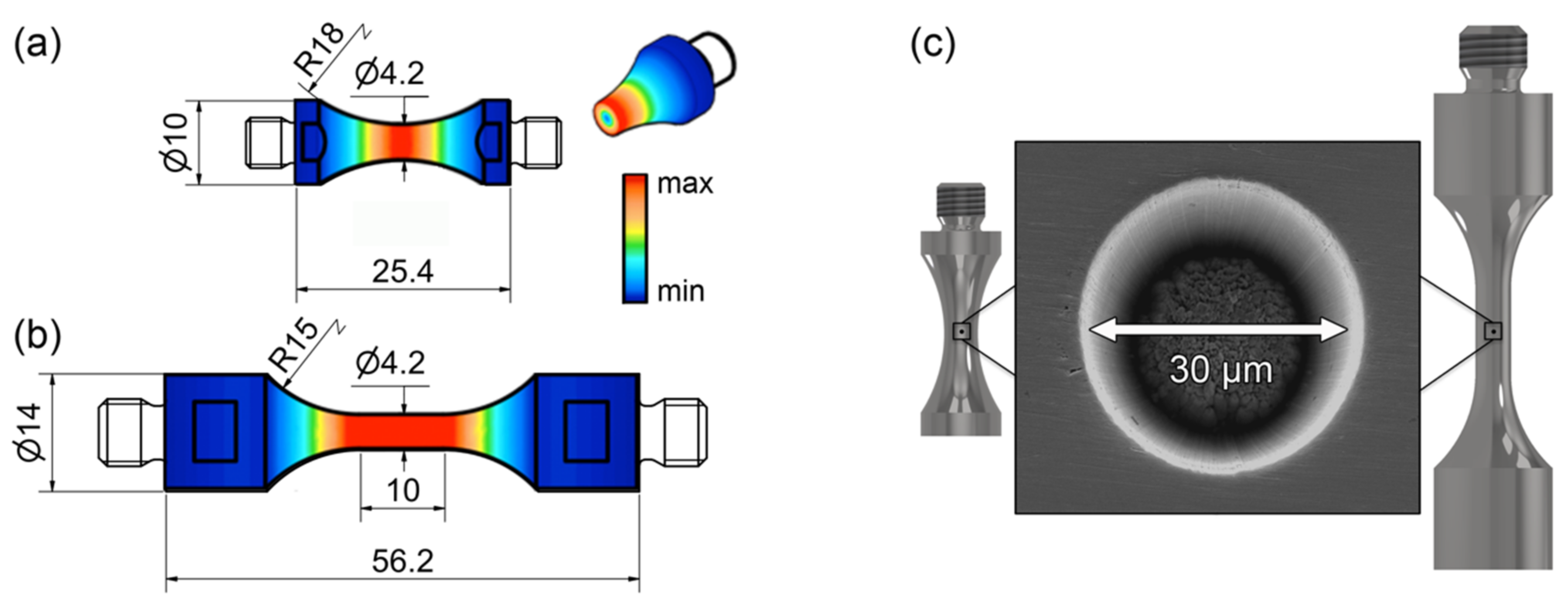

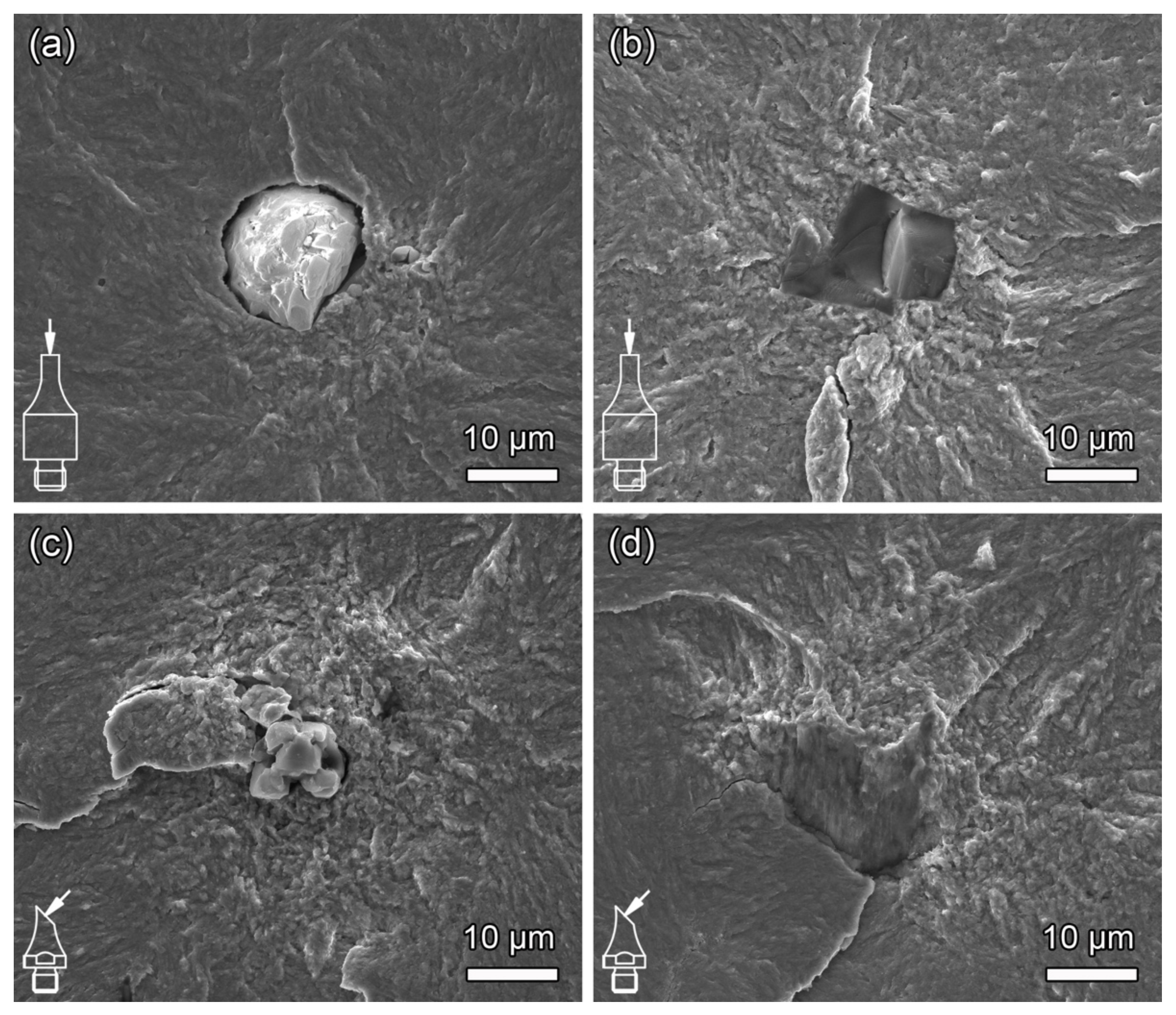
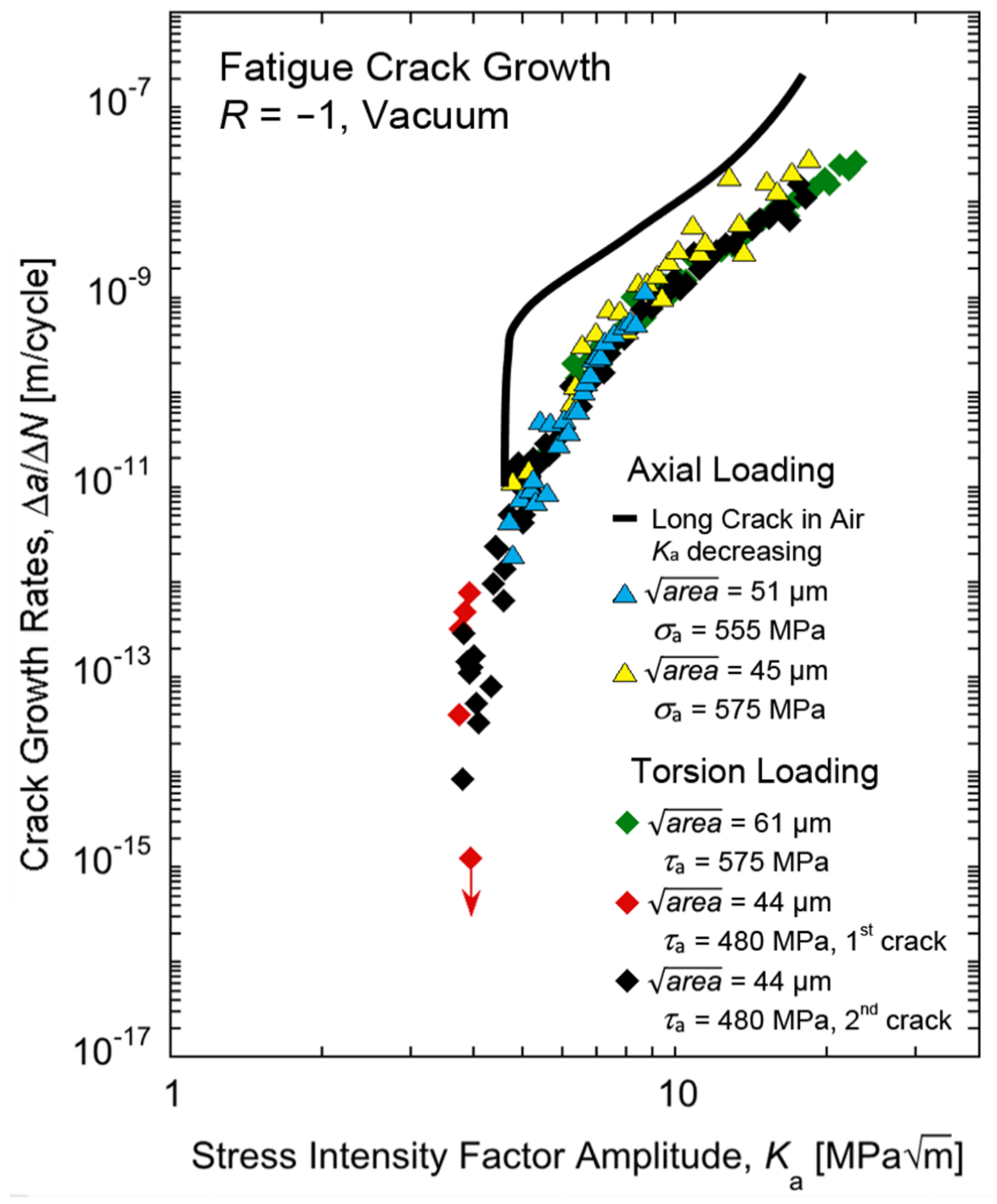
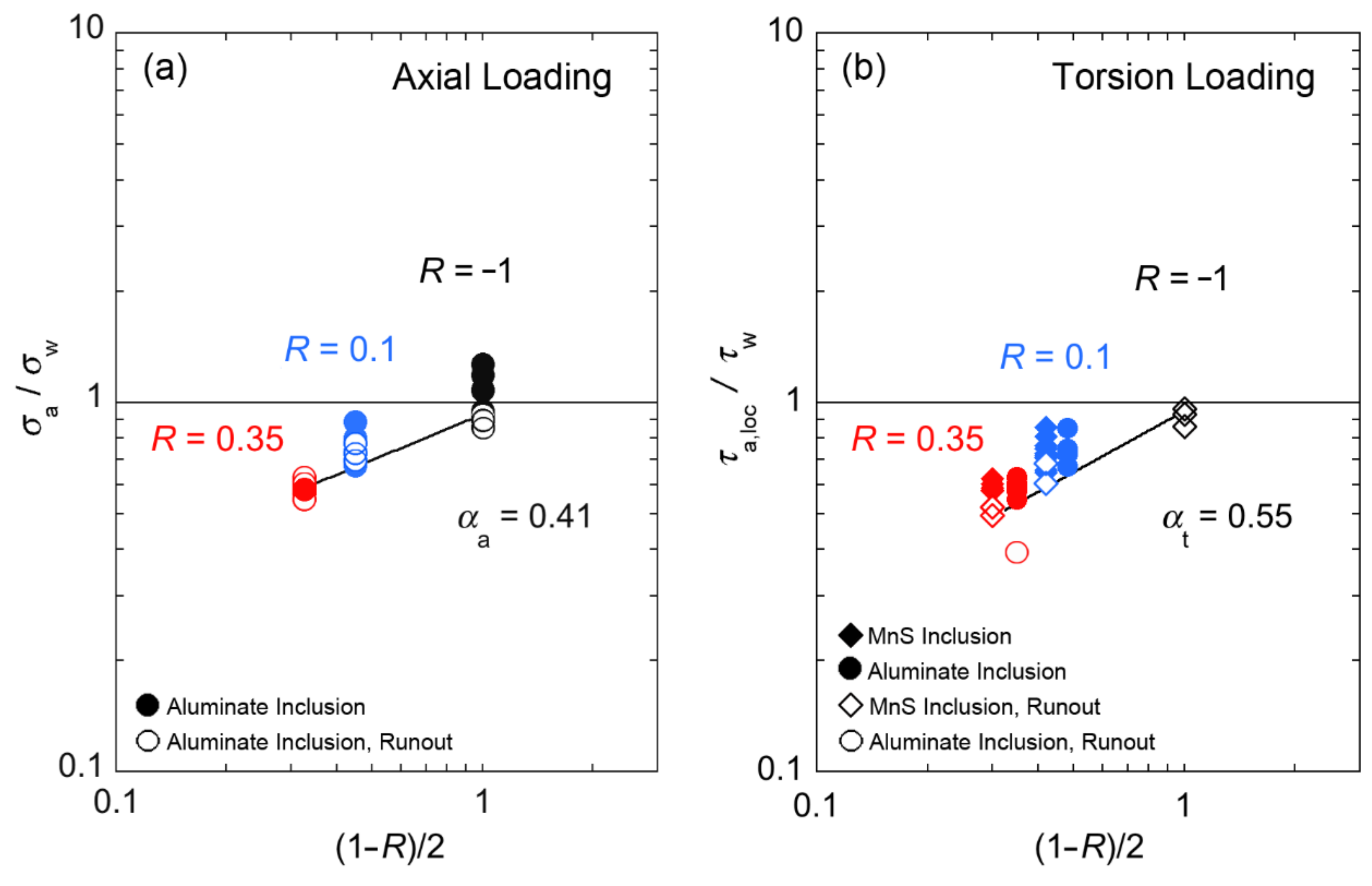
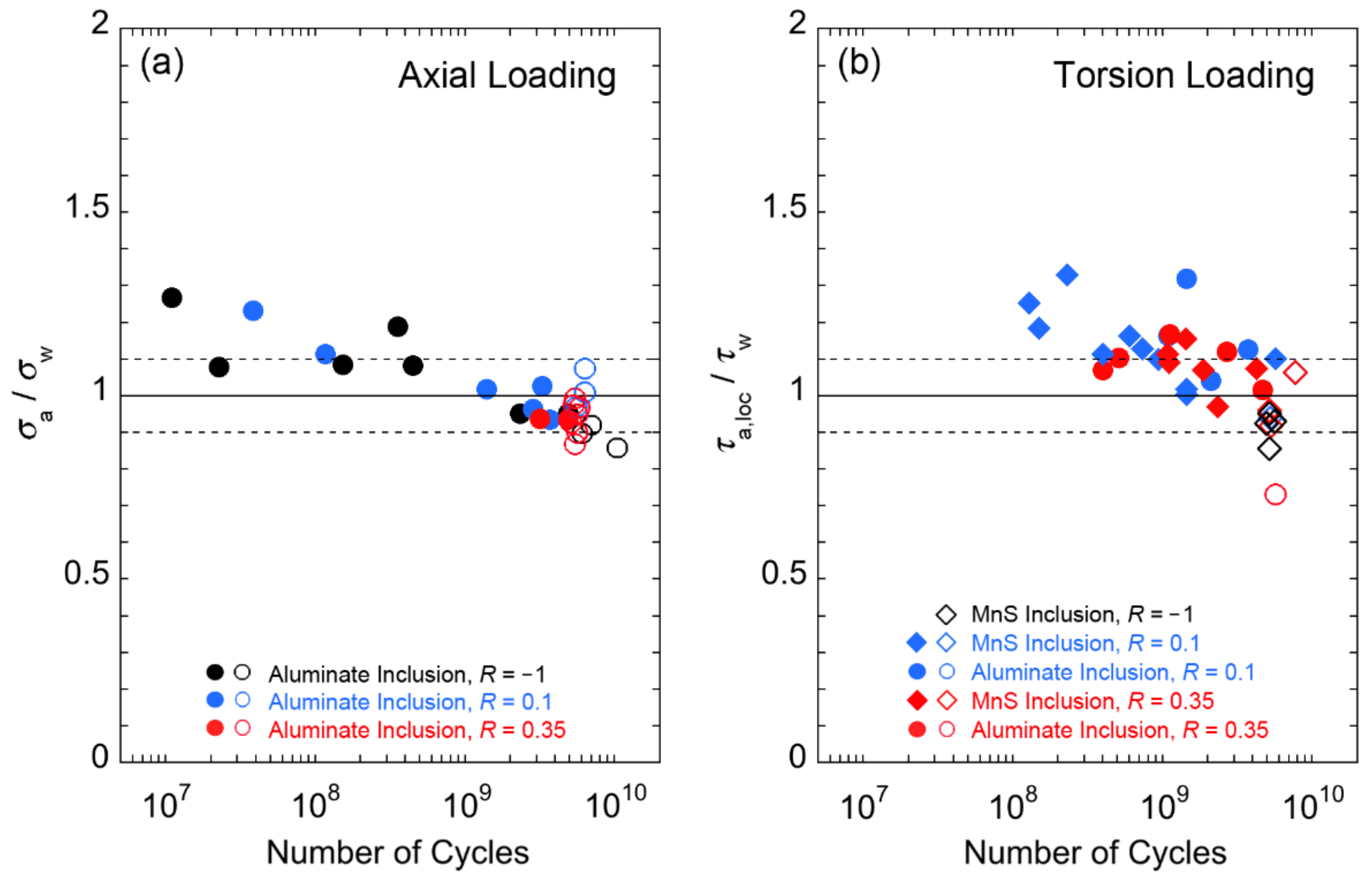

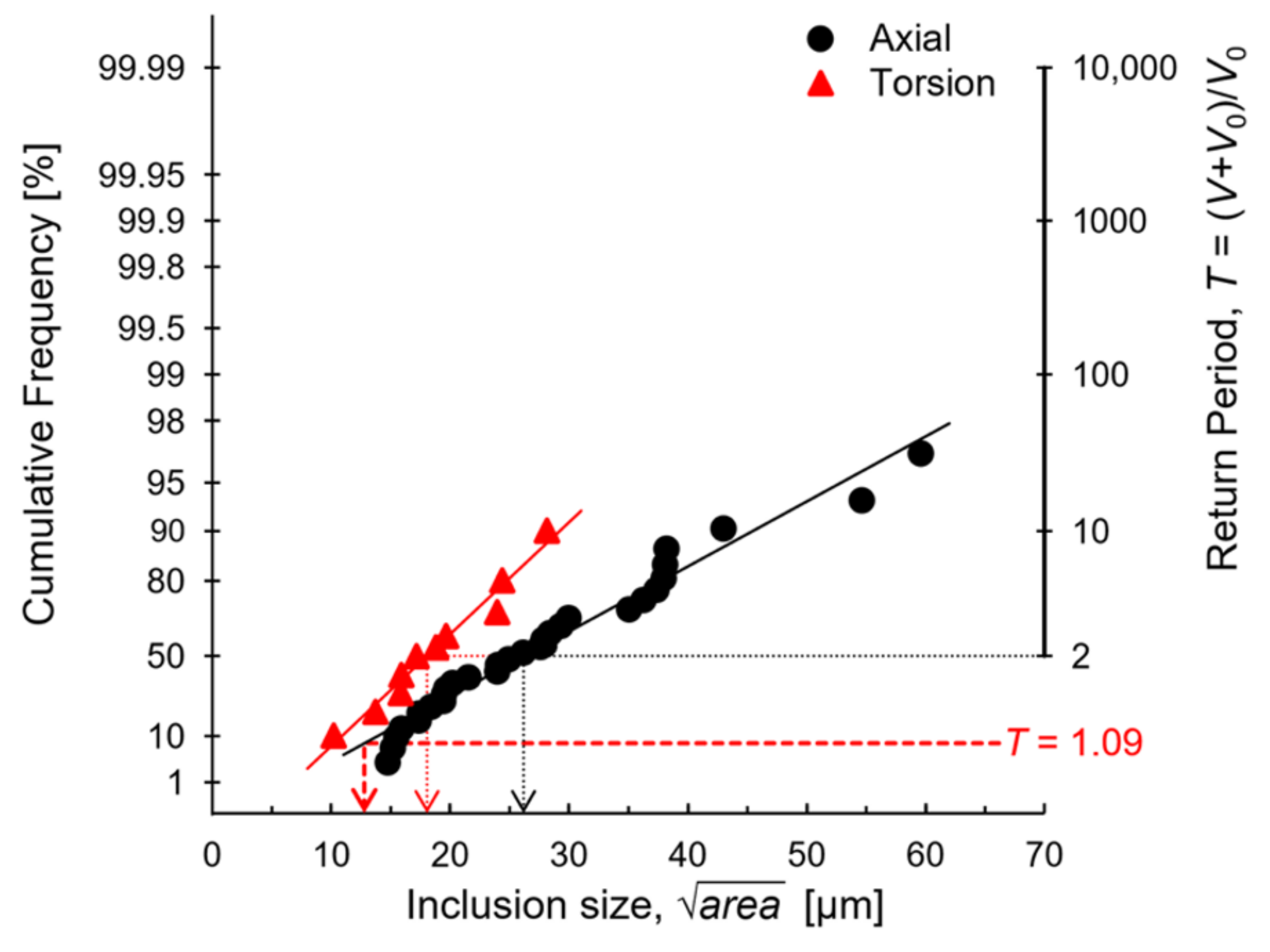

| C | Si | Mn | Cr | Al | Fe |
|---|---|---|---|---|---|
| 0.55 | 1.50 | 0.70 | 0.70 | 0.003 | balance |
| Yield Strength (MPa) | Tensile Strength (MPa) | Elongation (%) | Shear Yield Strength (MPa) | Shear Strength (MPa) | Vickers Hardness (HV) |
|---|---|---|---|---|---|
| 1720 | 1910 | 10 | 1400 | 1550 | 530 |
| R = −1 | R = 0.1 | R = 0.35 | ||||
|---|---|---|---|---|---|---|
| Min | Max | Min | Max | Min | Max | |
| Axial: | ||||||
| Aluminate | 17.0 | 61.6 | 12.4 | 54.6 | 15.5 | 27.6 |
| Torsion: | ||||||
| Aluminate | 10.2 | 28.2 | 13.8 | 24.0 | ||
| MnS | 9.5 | 24.5 | 13.5 | 21.2 | ||
| MnS (runouts) | 8.8 | 15.4 | 7.4 | 14.4 | 9.7 | 20.0 |
Publisher’s Note: MDPI stays neutral with regard to jurisdictional claims in published maps and institutional affiliations. |
© 2022 by the authors. Licensee MDPI, Basel, Switzerland. This article is an open access article distributed under the terms and conditions of the Creative Commons Attribution (CC BY) license (https://creativecommons.org/licenses/by/4.0/).
Share and Cite
Karr, U.; Schönbauer, B.M.; Sandaiji, Y.; Mayer, H. Effects of Non-Metallic Inclusions and Mean Stress on Axial and Torsion Very High Cycle Fatigue of SWOSC-V Spring Steel. Metals 2022, 12, 1113. https://doi.org/10.3390/met12071113
Karr U, Schönbauer BM, Sandaiji Y, Mayer H. Effects of Non-Metallic Inclusions and Mean Stress on Axial and Torsion Very High Cycle Fatigue of SWOSC-V Spring Steel. Metals. 2022; 12(7):1113. https://doi.org/10.3390/met12071113
Chicago/Turabian StyleKarr, Ulrike, Bernd M. Schönbauer, Yusuke Sandaiji, and Herwig Mayer. 2022. "Effects of Non-Metallic Inclusions and Mean Stress on Axial and Torsion Very High Cycle Fatigue of SWOSC-V Spring Steel" Metals 12, no. 7: 1113. https://doi.org/10.3390/met12071113
APA StyleKarr, U., Schönbauer, B. M., Sandaiji, Y., & Mayer, H. (2022). Effects of Non-Metallic Inclusions and Mean Stress on Axial and Torsion Very High Cycle Fatigue of SWOSC-V Spring Steel. Metals, 12(7), 1113. https://doi.org/10.3390/met12071113






